2016 TOYOTA TUNDRA power steering
[x] Cancel search: power steeringPage 420 of 588
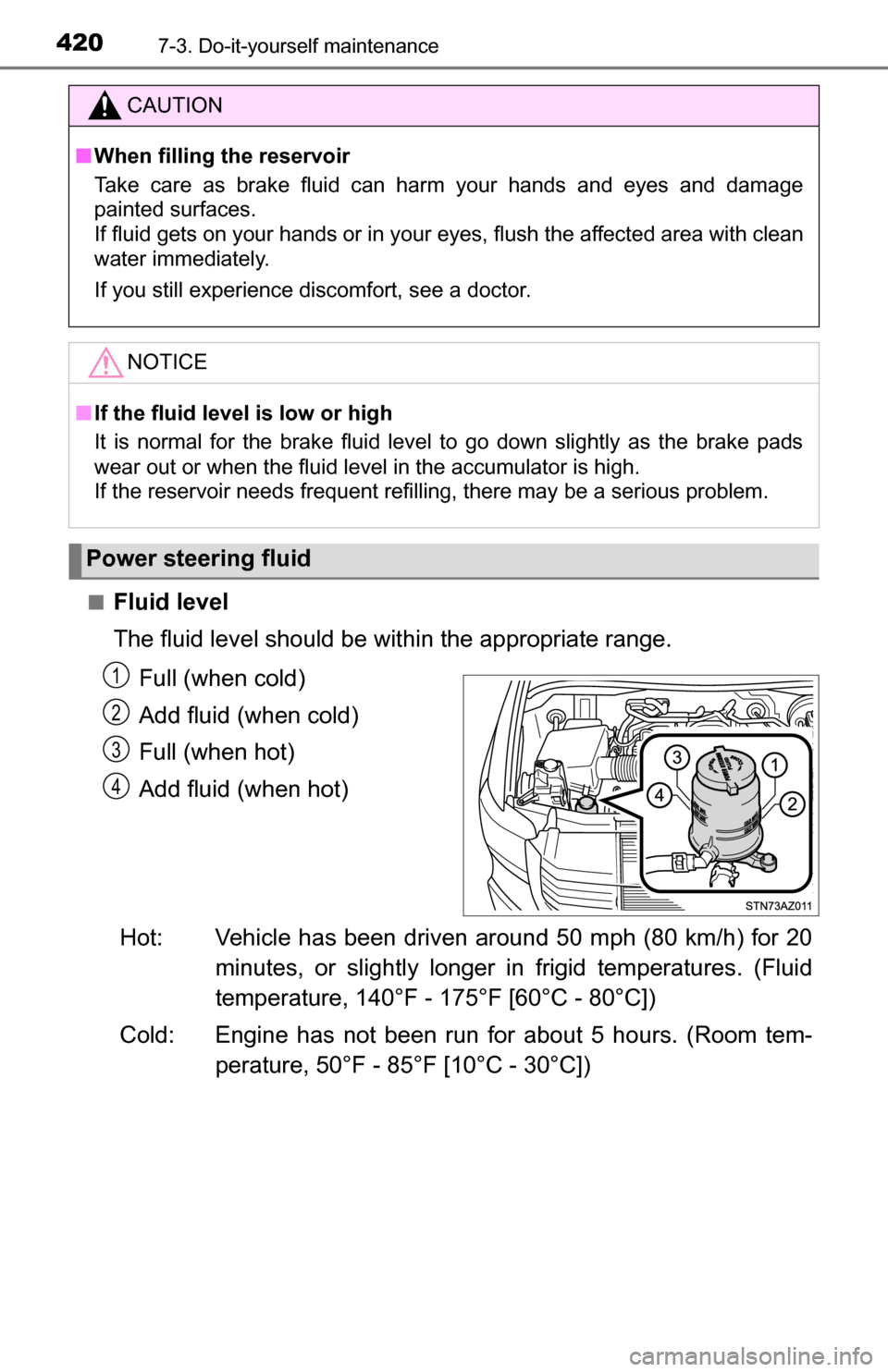
4207-3. Do-it-yourself maintenance
■Fluid level
The fluid level should be within the appropriate range.Full (when cold)
Add fluid (when cold)
Full (when hot)
Add fluid (when hot)
Hot: Vehicle has been driven around 50 mph (80 km/h) for 20 minutes, or slightly longer in frigid temperatures. (Fluid
temperature, 140°F - 175°F [60°C - 80°C])
Cold: Engine has not been run for about 5 hours. (Room tem- perature, 50°F - 85°F [10°C - 30°C])
CAUTION
■When filling the reservoir
Take care as brake fluid can harm your hands and eyes and damage
painted surfaces.
If fluid gets on your hands or in your eyes, flush the affected area with clean
water immediately.
If you still experience discomfort, see a doctor.
NOTICE
■If the fluid level is low or high
It is normal for the brake fluid level to go down slightly as the brake pads
wear out or when the fluid level in the accumulator is high.
If the reservoir needs frequent refilling, there may be a serious problem.
Power steering fluid
1
2
3
4
Page 421 of 588
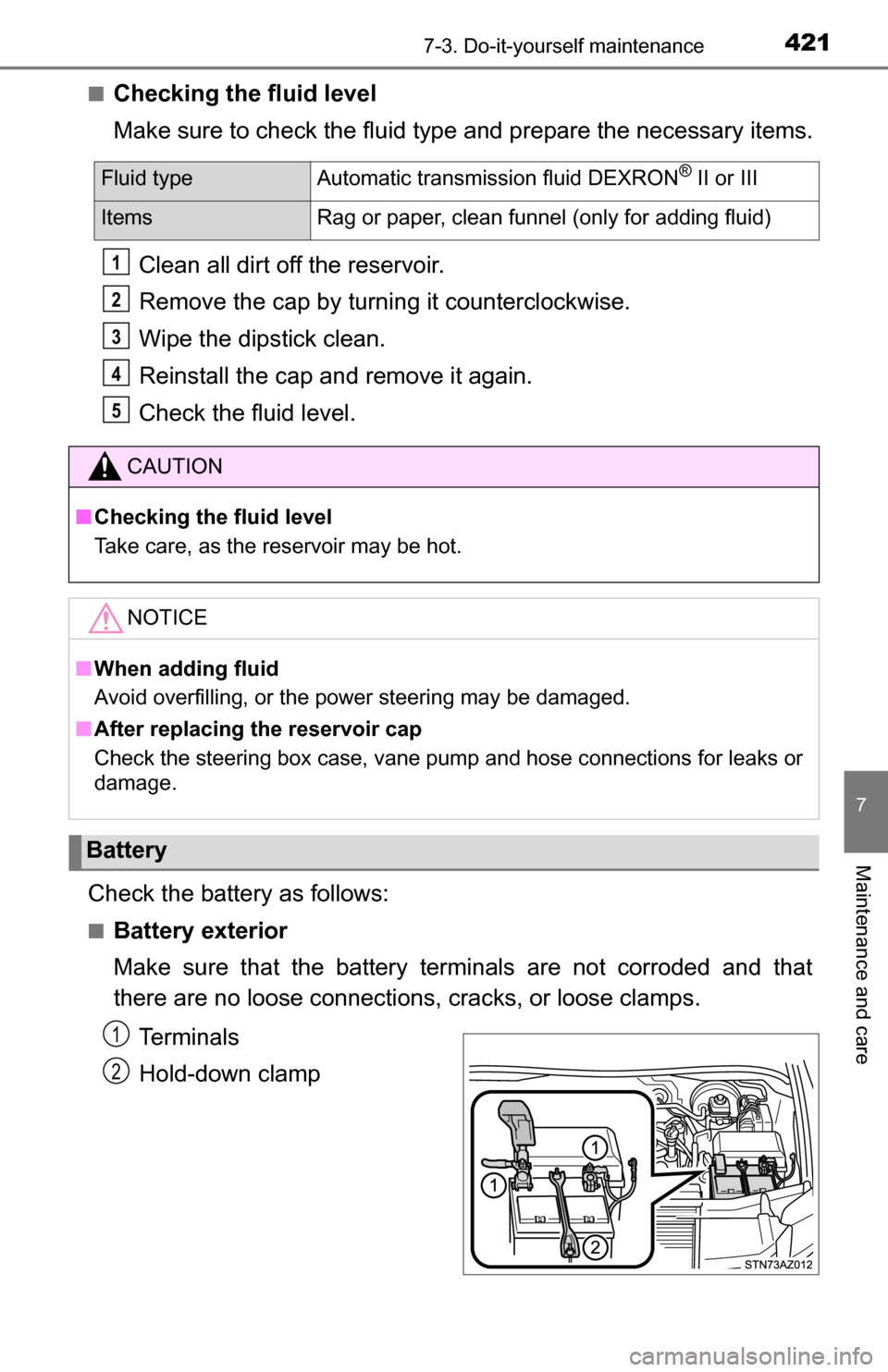
4217-3. Do-it-yourself maintenance
7
Maintenance and care
■Checking the fluid level
Make sure to check the fluid type and prepare the necessary items.Clean all dirt off the reservoir.
Remove the cap by turn ing it counterclockwise.
Wipe the dipstick clean.
Reinstall the cap and remove it again.
Check the fluid level.
Check the battery as follows:
■Battery exterior
Make sure that the battery terminals are not corroded and that
there are no loose connections, cracks, or loose clamps. Terminals
Hold-down clamp
Fluid type Automatic transmission fluid DEXRON® II or III
Items Rag or paper, clean funnel (only for adding fluid)
CAUTION
■Checking the fluid level
Take care, as the reservoir may be hot.
NOTICE
■When adding fluid
Avoid overfilling, or the power steering may be damaged.
■ After replacing the reservoir cap
Check the steering box case, vane pump and hose connections for leaks or
damage.
Battery
1
2
3
4
5
1
2
Page 465 of 588
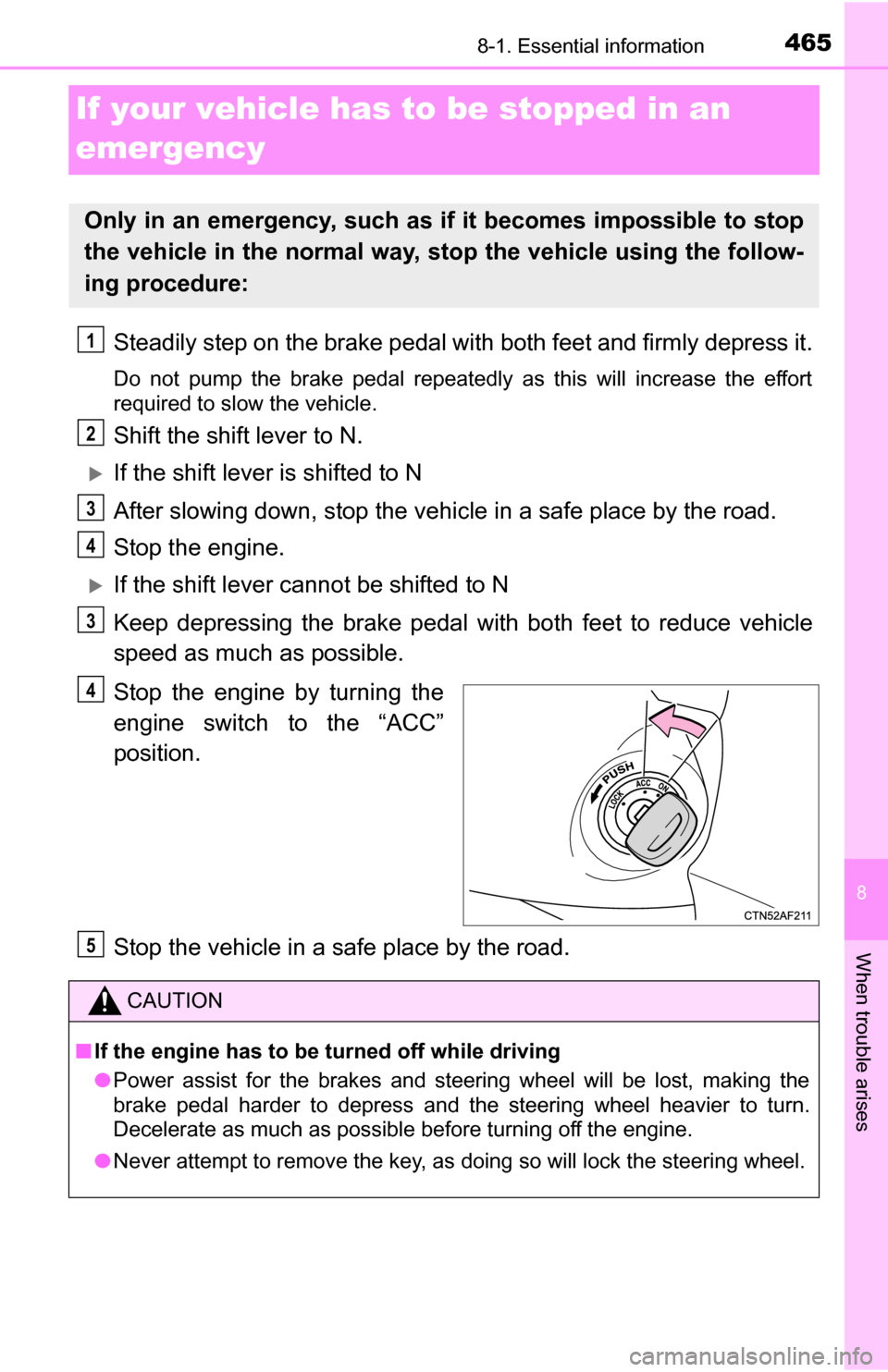
465
8
When trouble arises
8-1. Essential information
If your vehicle has to be stopped in an
emergency
Steadily step on the brake pedal with both feet and firmly depress it.
Do not pump the brake pedal repeatedly as this will increase the effort
required to slow the vehicle.
Shift the shift lever to N.
If the shift lever is shifted to N
After slowing down, stop the vehicle in a safe place by the road.
Stop the engine.
If the shift lever cannot be shifted to N
Keep depressing the brake pedal with both feet to reduce vehicle
speed as much as possible.
Stop the engine by turning the
engine switch to the “ACC”
position.
Stop the vehicle in a safe place by the road.
Only in an emergency, such as if it becomes impossible to stop
the vehicle in the normal way, st op the vehicle using the follow-
ing procedure:
1
2
3
4
3
4
CAUTION
■ If the engine has to be turned off while driving
● Power assist for the brakes and steering wheel will be lost, making the
brake pedal harder to depress and the steering wheel heavier to turn.
Decelerate as much as possible before turning off the engine.
● Never attempt to remove the key, as doing so will lock the steering wheel.
5
Page 526 of 588
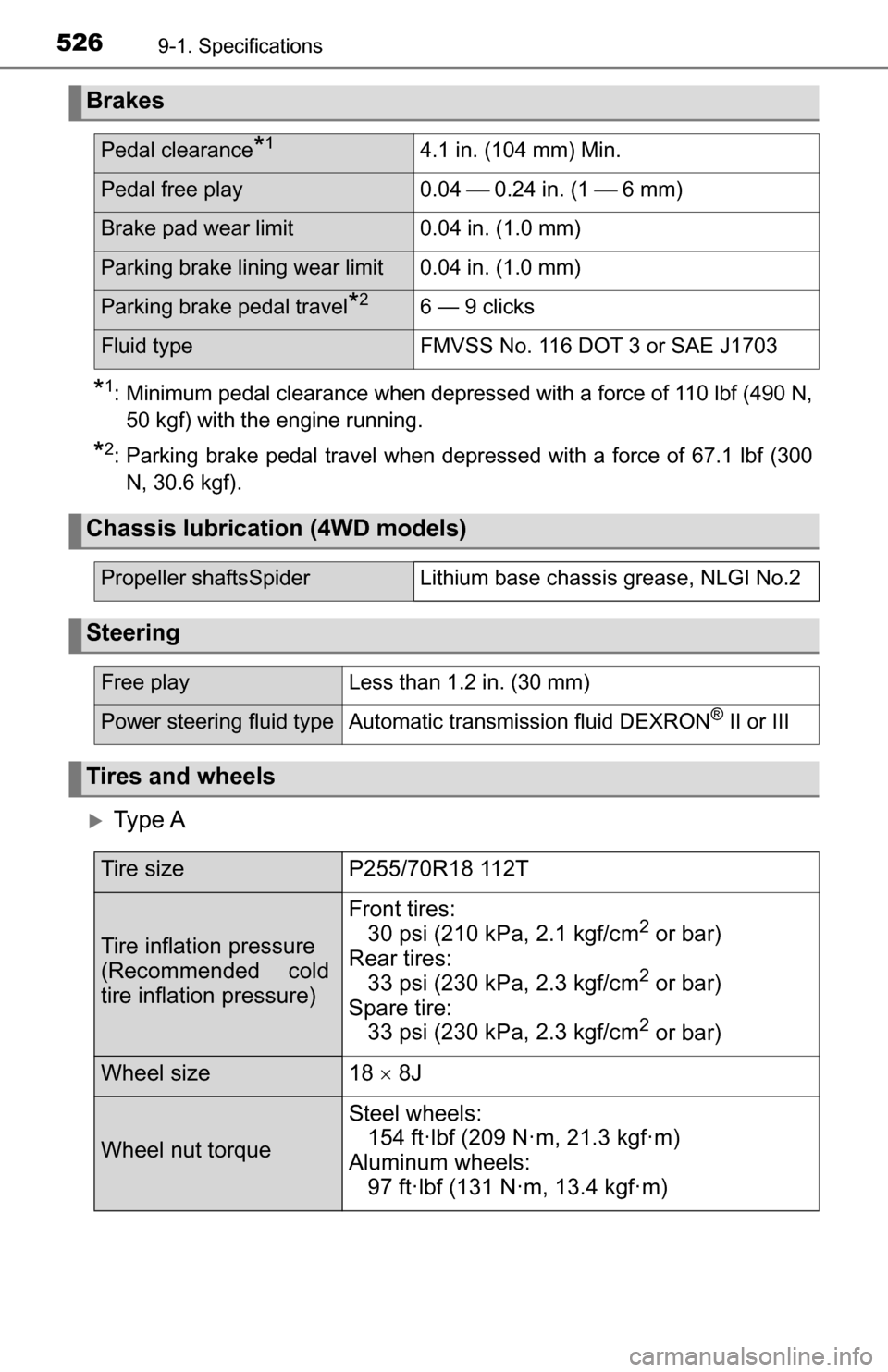
5269-1. Specifications
*1: Minimum pedal clearance when depressed with a force of 110 lbf (490 N,
50 kgf) with the engine running.
*2: Parking brake pedal travel when depressed with a force of 67.1 lbf (300 N, 30.6 kgf).
Ty p e A
Brakes
Pedal clearance*14.1 in. (104 mm) Min.
Pedal free play 0.04 0.24 in. (1 6 mm)
Brake pad wear limit0.04 in. (1.0 mm)
Parking brake lining wear limit 0.04 in. (1.0 mm)
Parking brake pedal travel*26 — 9 clicks
Fluid type FMVSS No. 116 DOT 3 or SAE J1703
Chassis lubrication (4WD models)
Propeller shaftsSpider Lithium base chassis grease, NLGI No.2
Steering
Free playLess than 1.2 in. (30 mm)
Power steering fluid typeAutomatic transmission fluid DEXRON® II or III
Tires and wheels
Tire sizeP255/70R18 112T
Tire inflation pressure
(Recommended cold
tire inflation pressure)
Front tires:
30 psi (210 kPa, 2.1 kgf/cm2 or bar)
Rear tires: 33 psi (230 kPa, 2.3 kgf/cm
2 or bar)
Spare tire: 33 psi (230 kPa, 2.3 kgf/cm
2 or bar)
Wheel size18 8J
Wheel nut torque
Steel wheels:
154 ft·lbf (209 N·m, 21.3 kgf·m)
Aluminum wheels: 97 ft·lbf (131 N·m, 13.4 kgf·m)
Page 538 of 588

5389-1. Specifications
Glossary of tire terminology
Tire related termMeaning
Cold tire inflation pres-
sure
Tire pressure when the vehicle has been
parked for three hours or more, or has not
been driven more than 1 mile or 1.5 km under
that condition
Maximum inflation
pressureThe maximum cold inflated pressure to which
a tire may be inflated, shown on the sidewall
of the tire
Recommended infla-
tion pressureCold tire inflation pressure recommended by a
manufacturer
Accessory weight
The combined weight (in excess of those stan-
dard items which may be replaced) of auto-
matic transmission, power steering, power
brakes, power windows, power seats, radio
and heater, to the extent that these items are
available as factory-installed equipment
(whether installed or not)
Curb weight
The weight of a motor vehicle with standard
equipment, including the maximum capacity of
fuel, oil and coolant, and if so equipped, air
conditioning and additional weight optional
engine
Maximum loaded vehi-
cle weight
The sum of:
(a) Curb weight
(b) Accessory weight
(c) Vehicle capacity weight
(d) Production options weight
Normal occupant
weight150 lb. (68 kg) times the number of occupants
specified in the second column of Table 1
*
that follows
Occupant distributionDistribution of occupants in a vehicle as speci-
fied in the third column of Table 1
* below
Production options
weight
The combined weight of installed regular pro-
duction options weighing over 5 lb. (2.3 kg) in
excess of the standard items which they
replace, not previously considered in curb
weight or accessory weight, including heavy
duty brakes, ride levelers, roof rack, heavy
duty battery, and special trim
Page 571 of 588
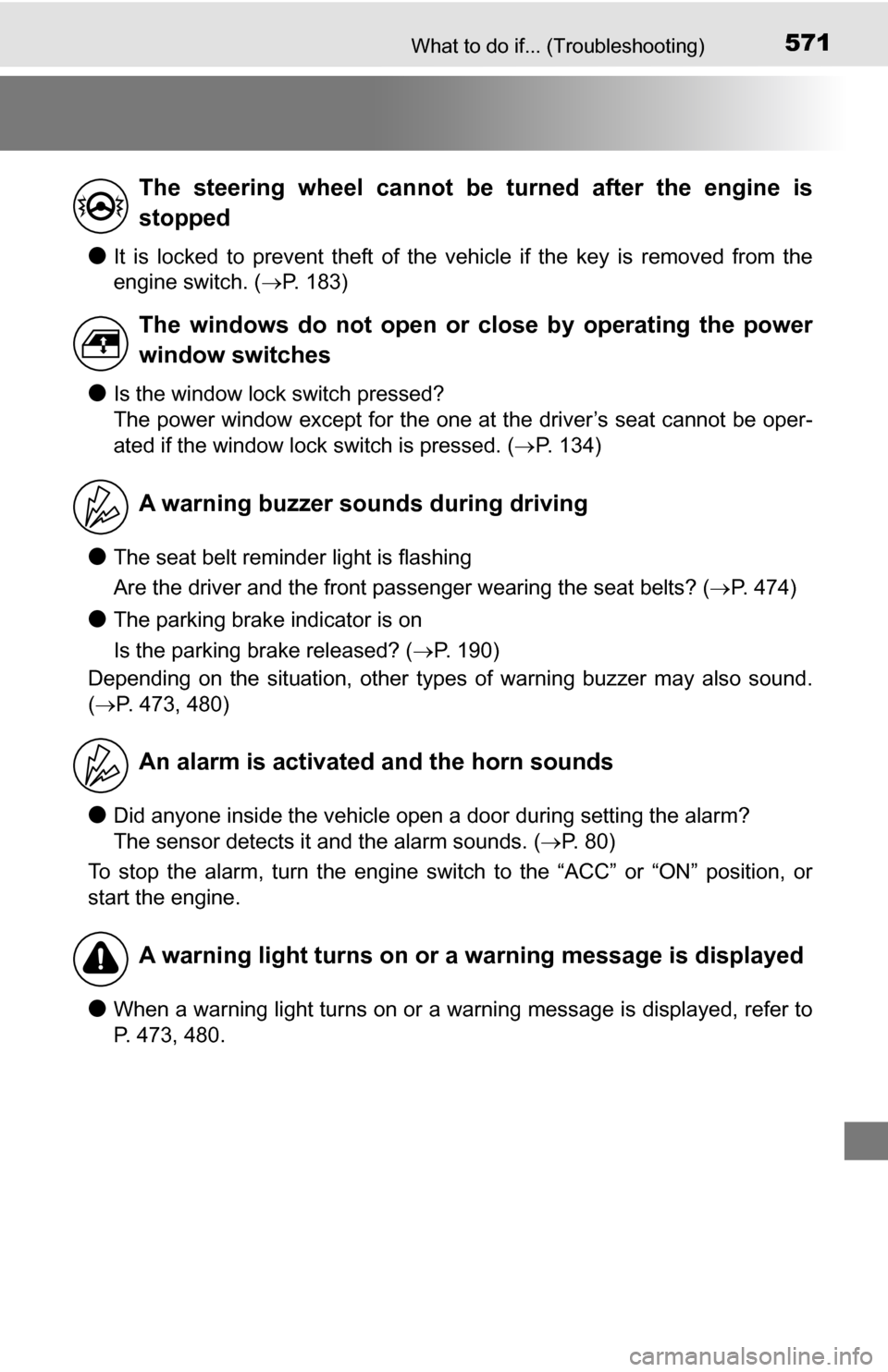
571What to do if... (Troubleshooting)
●It is locked to prevent theft of the vehicle if the key is removed from the
engine switch. (P. 183)
●Is the window lock switch pressed?
The power window except for the one at the driver’s seat cannot be oper-
ated if the window lock switch is pressed. ( P. 134)
●The seat belt reminder light is flashing
Are the driver and the front passenger wearing the seat belts? ( P. 474)
●The parking brake indicator is on
Is the parking brake released? (P. 190)
Depending on the situation, other types of warning buzzer may also sound.
( P. 473, 480)
●Did anyone inside the vehicle open a door during setting the alarm?
The sensor detects it and the alarm sounds. ( P. 80)
To stop the alarm, turn the engine switch to the “ACC” or “ON” position, or
start the engine.
●When a warning light turns on or a warning message is displayed, refer to
P. 473, 480.
The steering wheel cannot be turned after the engine is
stopped
The windows do not open or close by operating the power
window switches
A warning buzzer sounds during driving
An alarm is activated and the horn sounds
A warning light turns on or a warning message is displayed
Page 581 of 588
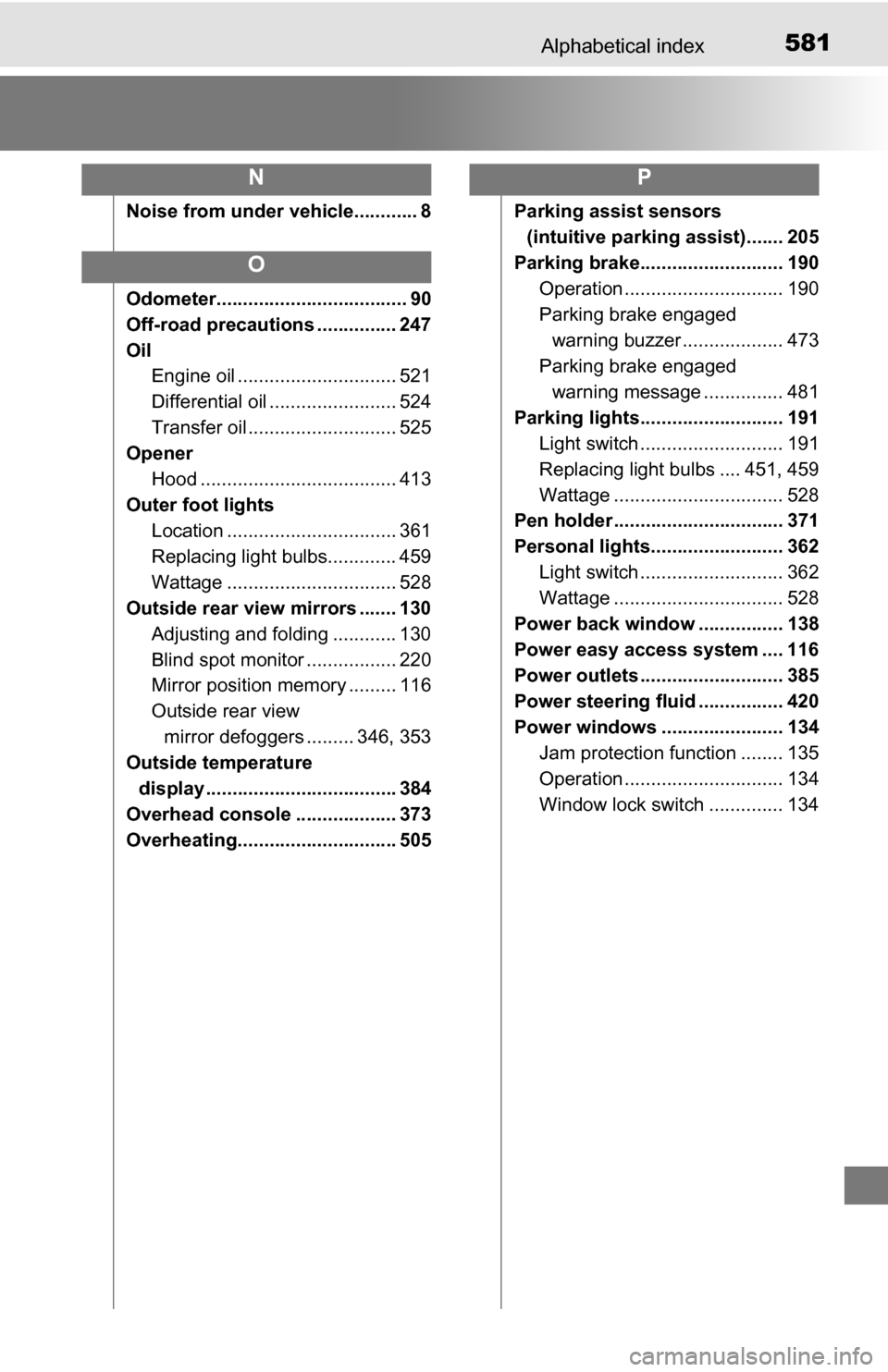
581Alphabetical index
Noise from under vehicle............ 8
Odometer.................................... 90
Off-road precautions ............... 247
Oil Engine oil .............................. 521
Differential oil ........................ 524
Transfer oil ............................ 525
Opener
Hood ..................................... 413
Outer foot lights Location ................................ 361
Replacing light bulbs............. 459
Wattage ................................ 528
Outside rear view mirrors ....... 130
Adjusting and folding ............ 130
Blind spot monitor ................. 220
Mirror position memory ......... 116
Outside rear view mirror defoggers ......... 346, 353
Outside temperature
display .................................... 384
Overhead console ................... 373
Overheating.............................. 505 Parking assist sensors
(intuitive parking assist)....... 205
Parking brake........................... 190 Operation .............................. 190
Parking brake engaged
warning buzzer ................... 473
Parking brake engaged
warning message ............... 481
Parking lights........................... 191 Light switch ........................... 191
Replacing light bulbs .... 451, 459
Wattage ................................ 528
Pen holder ................................ 371
Personal lights......................... 362
Light switch ........................... 362
Wattage ................................ 528
Power back window ................ 138
Power easy access system .... 116
Power outlets ........................... 385
Power steering fluid ................ 420
Power windows ....................... 134 Jam protection function ........ 135
Operation .............................. 134
Window lock switch .............. 134
N
O
P
Page 584 of 588
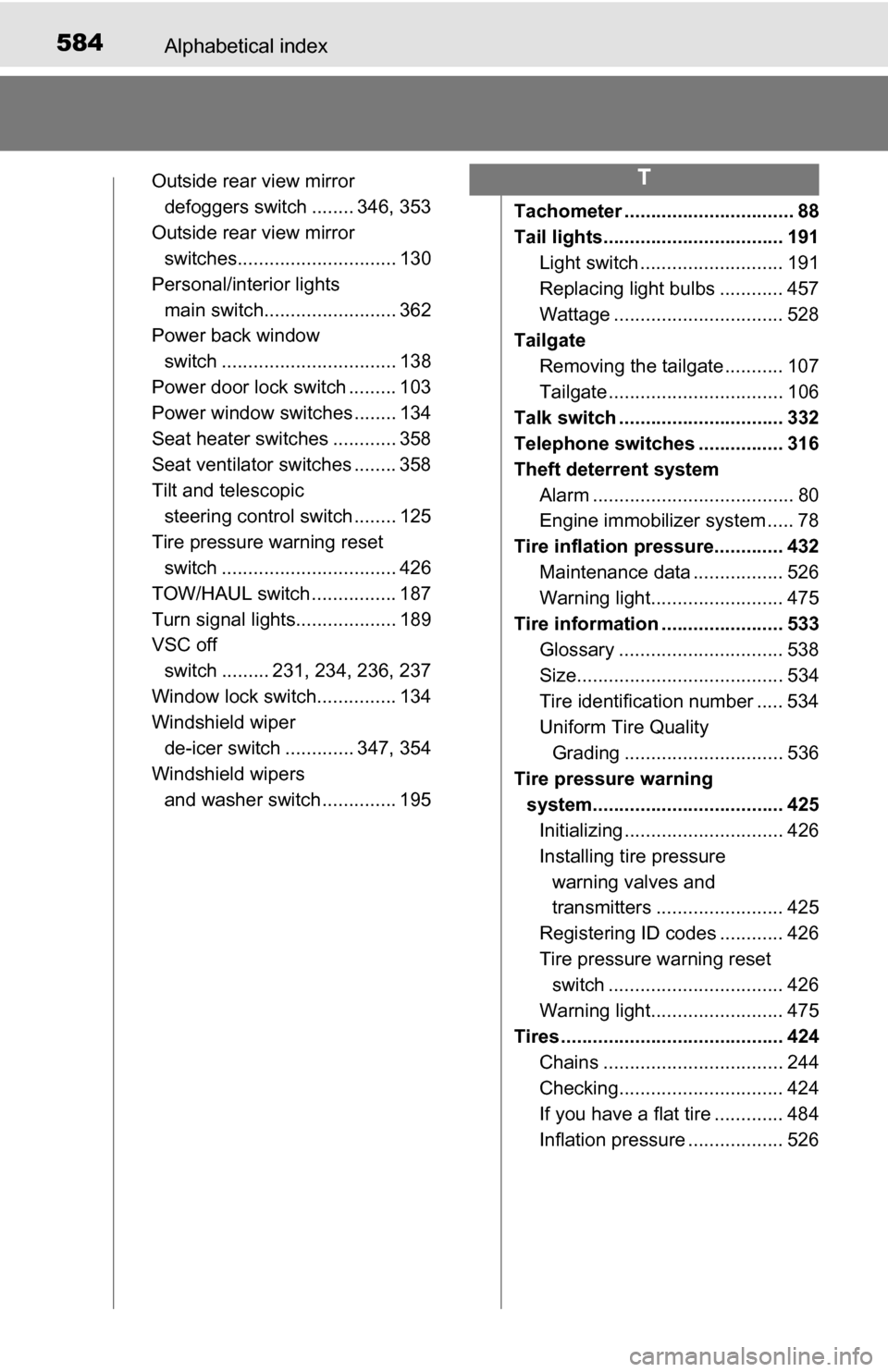
584Alphabetical index
Outside rear view mirror defoggers switch ........ 346, 353
Outside rear view mirror
switches.............................. 130
Personal/interior lights main switch......................... 362
Power back window
switch ................................. 138
Power door lock switch ......... 103
Power window switches ........ 134
Seat heater switches ............ 358
Seat ventilator switches ........ 358
Tilt and telescopic steering control switch ........ 125
Tire pressure warning reset switch ................................. 426
TOW/HAUL switch ................ 187
Turn signal lights................... 189
VSC off switch ......... 231, 234, 236, 237
Window lock switch............... 134
Windshield wiper de-icer switch ............. 347, 354
Windshield wipers and washer switch .............. 195 Tachometer ................................ 88
Tail lights.................................. 191
Light switch ........................... 191
Replacing light bulbs ............ 457
Wattage ................................ 528
Tailgate Removing the tailgate ........... 107
Tailgate ................................. 106
Talk switch ............................... 332
Telephone switches ................ 316
Theft deterrent system Alarm ...................................... 80
Engine immobilizer system ..... 78
Tire inflation pressure............. 432 Maintenance data ................. 526
Warning light......................... 475
Tire information ....................... 533 Glossary ............................... 538
Size....................................... 534
Tire identification number ..... 534
Uniform Tire Quality Grading .............................. 536
Tire pressure warning system.................................... 425 Initializing .............................. 426
Installing tire pressure
warning valves and
transmitters ........................ 425
Registering ID codes ............ 426
Tire pressure warning reset switch ................................. 426
Warning light......................... 475
Tires .......................................... 424 Chains .................................. 244
Checking............................... 424
If you have a flat tire ............. 484
Inflation pressure .................. 526T